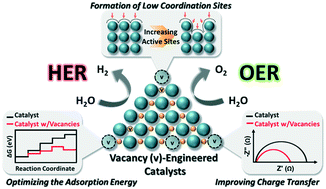当前位置:
X-MOL 学术
›
CrystEngComm
›
论文详情
Our official English website, www.x-mol.net, welcomes your
feedback! (Note: you will need to create a separate account there.)
Vacancy-engineered catalysts for water electrolysis
CrystEngComm ( IF 2.6 ) Pub Date : 2020/01/07 , DOI: 10.1039/c9ce01883b Songa Choi 1, 2, 3, 4 , Yeji Park 1, 2, 3, 4 , Heesu Yang 1, 2, 3, 4 , Haneul Jin 1, 2, 3, 4 , Gracita M. Tomboc 1, 2, 3, 4 , Kwangyeol Lee 1, 2, 3, 4
CrystEngComm ( IF 2.6 ) Pub Date : 2020/01/07 , DOI: 10.1039/c9ce01883b Songa Choi 1, 2, 3, 4 , Yeji Park 1, 2, 3, 4 , Heesu Yang 1, 2, 3, 4 , Haneul Jin 1, 2, 3, 4 , Gracita M. Tomboc 1, 2, 3, 4 , Kwangyeol Lee 1, 2, 3, 4
Affiliation

|
The development of electrochemical energy conversion and storage technologies is pivotal to the full-fledged utilization of renewable energy sources. The successful commercial application of water electrolysis to produce hydrogen gas, in particular, requires highly active electrocatalysts that can operate for prolonged periods. However, the high activity and high durability of electrocatalysts are often mutually exclusive. Recent studies have demonstrated that vacancy engineering might effectively modulate the electronic structures of catalysts, which can lead to high catalytic activity. Furthermore, it has been shown that vacancies are closely related to catalyst stability under operational conditions. To understand the benefits of vacancies in the catalyst structures, we discuss the recent advances in the development of vacancy-engineered catalysts for water electrolysis. In addition, we discuss the present limitations in this nascent field and provide directions for valuable future research.
中文翻译:

空缺设计的水电解催化剂
电化学能量转换和存储技术的发展对于全面利用可再生能源至关重要。水电解生产氢气的成功商业应用尤其需要能够长时间运行的高活性电催化剂。然而,电催化剂的高活性和高耐久性通常是相互排斥的。最近的研究表明,空缺工程可能有效地调节催化剂的电子结构,从而导致高催化活性。此外,已经表明空位与催化剂在操作条件下的稳定性密切相关。要了解空位对催化剂结构的好处,我们讨论了空缺设计的水电解催化剂开发的最新进展。此外,我们讨论了这个新兴领域的当前局限性,并为今后的有价值的研究提供了指导。
更新日期:2020-03-03
中文翻译:

空缺设计的水电解催化剂
电化学能量转换和存储技术的发展对于全面利用可再生能源至关重要。水电解生产氢气的成功商业应用尤其需要能够长时间运行的高活性电催化剂。然而,电催化剂的高活性和高耐久性通常是相互排斥的。最近的研究表明,空缺工程可能有效地调节催化剂的电子结构,从而导致高催化活性。此外,已经表明空位与催化剂在操作条件下的稳定性密切相关。要了解空位对催化剂结构的好处,我们讨论了空缺设计的水电解催化剂开发的最新进展。此外,我们讨论了这个新兴领域的当前局限性,并为今后的有价值的研究提供了指导。











































 京公网安备 11010802027423号
京公网安备 11010802027423号